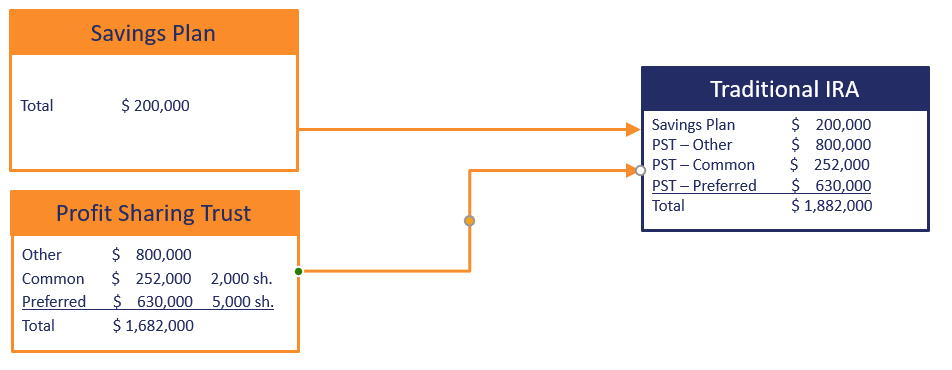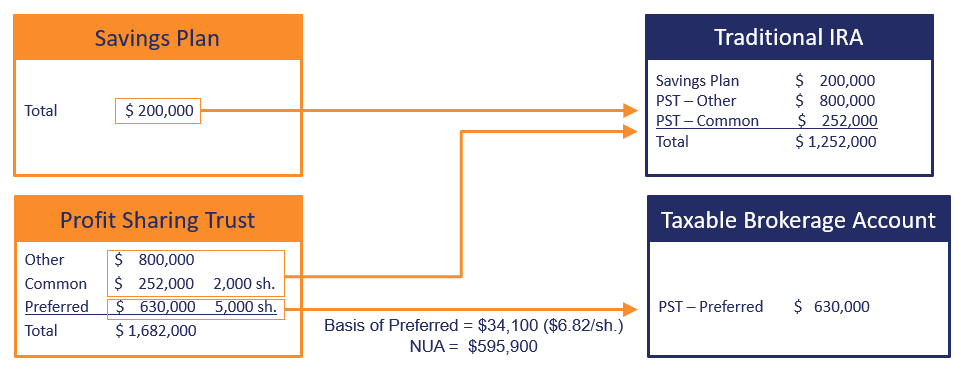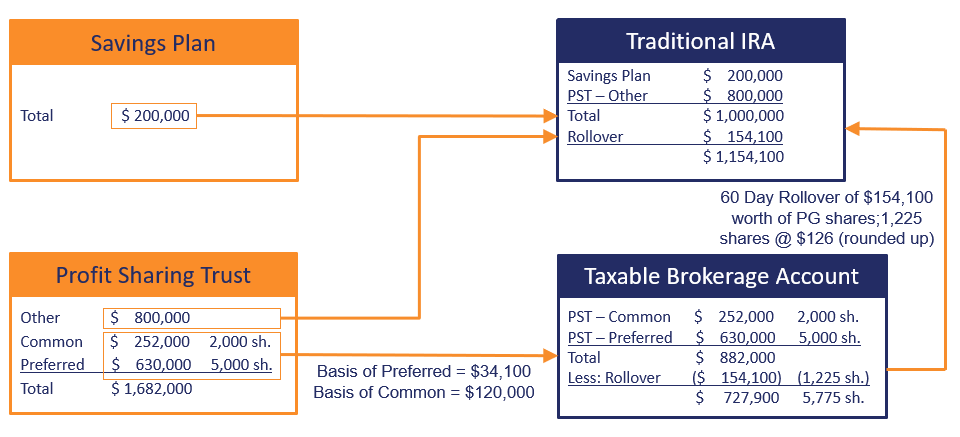Distribution Options for Your P&G Retirement Assets: The Frank Duke Method & Its Alternatives
Last month, we introduced a series on the Frank Duke Method—a potentially tax-savings technique commonly discussed in P&G circles. In the first article, we provided an overview of the method, its history, and its goals. In this month’s article, we detail how it works and compare it to other methods for distributing P&G retirement funds.
Before we dive into this topic, however, it is important to understand what happens to your P&G retirement accounts when you retire or separate from the company. To put it simply, the ball is in your court. Technically, you don’t have to do anything until you turn 72, when federal tax law requires you to withdraw funds from retirement accounts. If you were to leave your accounts alone until then, your investments would remain exactly as they were the day you separated from P&G.
Most people, however, choose to transfer the funds out of their P&G accounts and into other vehicles, such as an IRA. The most common approach for this is known as a Qualified Lump Sum Distribution (QLSD). With a QLSD, you move all of the assets from a retirement account and into a different account(s). The most common benefits of the P&G QLSD include more control over investments and potentially lower taxes.
Below, we will walk you through three different approaches to the QLSD for your P&G retirement assets:
- QLSD Total Rollover
- Split QLSD
- Duke Method Split QLSD
How Does a Qualified Lump Sum Distribution Work?
A QLSD is the first and total distribution of your P&G Savings Plan (SP) and Profit Sharing Trust (PST) assets, and you can take it upon retirement, termination, reaching age 59 ½, or death. For a distribution to qualify as a QLSD, the account balances in both your SP and PST plans must be ZERO by December 31 of the year you take your first distribution. As long as the accounts are completely empty on December 31, a residual dividend or additional PST contribution paid in the subsequent calendar year will not negate QLSD treatment.
To better understand the QLSD in practice, let’s imagine Michelle, an executive who has worked at P&G for 30 years and holds $200,000 in her savings plan and $1,682,000 in her profit-sharing plan. Michelle is 58 years old when she retires from P&G, and at the time, her income tax rate is expected to average 35% throughout her lifetime.
A Simple Approach: The QLSD Total Rollover
The QLSD Total Rollover is the most straightforward of the three approaches. Using this method, Michelle will take all of the assets in her SP and PST and roll the total, or $1,882,000, into a traditional IRA.

Because she’s moving funds from one qualified retirement account to an IRA, the IRS considers this rollover a non-taxable event. As a result, she will not owe any taxes on these assets during the year she transfers the funds. Instead, she will owe income tax whenever she withdraws funds from the account.
Let’s assume that Michelle withdraws $50,000 from her IRA each year of her retirement. In the first year, when she rolls over her assets into the IRA, she withdraws no funds and owes no income tax. The following year, though, she will owe $17,500 on the $50,000 she withdraws.
This approach can work well for some retirees, depending on their financial situation and future goals. It’s worth noting, though, that once you opt for the total rollover QLSD, you can no longer use the Duke Method; it requires that you spread your retirement fund assets into multiple accounts.
Shifting Assets and Lowering Taxes: The Split QLSD
While the total rollover QLSD is the simplest distribution method, the split QLSD is more common. With this approach, retirement assets are still distributed all at once. But they are rolled into several accounts, instead of just one. By “splitting” the retirement assets into different accounts, some assets can be taxed as long-term capital gains, instead of as ordinary income.
Typically, in a split QLSD, the account holder rolls over some assets to a traditional IRA and the rest to a taxable brokerage account. For P&G account holders, the most common, and often the most advantageous approach is to move all the PG preferred stock into a taxable brokerage account. The remaining assets—from both the SP and PST accounts (including the PG common stock)—are transferred to a traditional IRA.

Unlike the total rollover QLSD, this method causes an immediate tax event. The preferred PG stock that goes into the taxable account will be taxed as ordinary income, since it’s no longer held in a retirement account and can be accessed at any time with no restriction or penalty.
That taxable income is calculated in a particular way. Instead of assessing ordinary income tax on the shares’ market value, ordinary income tax is assessed on the trustees’ cost—essentially, the ‘cost’ of company stock within your P&G retirement accounts.
In our example, the trustees’ cost of Michelle’s shares is $6.82 per share, or $34,100 total. Therefore, in the year Michelle takes her QLSD, she will owe ordinary income tax on $34,100. However, the rest of the shares’ value—the other $595,900 (the NUA)—won’t be taxed that year. Instead, Michelle will only pay tax when she sells those shares. And when she does, 100% of the NUA will be taxed at the far more preferable long-term capital gains tax rate. Because long-term capital gains rates are typically much lower than an individual’s income tax rate, this can translate into significant tax savings!
As for the rest of Michelle’s PG shares, she will roll them into a traditional IRA. And because she is transferring those shares from one retirement account to another, that will be a non-taxable event. As is the case with the total rollover QLSD, she will pay taxes on those funds when they are withdrawn from the traditional IRA, at which time they will be taxed as ordinary income.
So, in this scenario, during the year of her QLSD, Michelle would owe $11,935.
One More Rollover Can Lower Taxes Further: The Duke Method
Drawing on a specific ruling by the IRS, Frank Duke devised a method to save P&G retirees even more on their taxes. In theory, this method can wipe out the need to pay income tax on a large portion of PG shares at the time of withdrawal – but only if it’s done correctly.
The Duke Method is more complicated than the previous approaches, but can generate even more tax savings. Basically, the account owner uses a two-step rollover approach. First, they make a split QLSD. They roll all of their Savings Plan assets into a traditional IRA, and they split their Profit-Sharing Trust assets, putting all of the PG shares into a taxable account and the remaining assets into their traditional IRA. For the second step, they make another transfer, a 60-day rollover, in which they move some of their PG shares out of their taxable account and into their traditional IRA.
Let’s look at what happens to Michelle if she uses the Duke Method. First, she rolls over all of her Savings Plan assets, or $200,000, into a traditional IRA. She then transfers all non-P&G investments from her Profit Sharing Trust, $800,000, to the IRA, while her PG shares, worth $882,000, go into a taxable account. If Michelle stops here, she will owe ordinary income tax on the trustees’ cost of shares transferred to the taxable account, $154,100. Again, assuming a 35% ordinary tax rate, this would equate to $53,935 or income tax.
What Frank Duke discovered, through a creative application of a private letter ruling, is that if Michelle then transfers $154,100 from her taxable account into her IRA within 60 days, that transfer will completely offset the trustees’ cost taxable income. Therefore, the QLSD would be seen as a non-taxable event. Michelle would avoid any ordinary income tax obligation on her PG shares during the year of her QLSD.
The following flow chart offers an illustration of these two steps:

This means that Michelle will receive $727,900 of PG stock with zero upfront tax costs in an account that has no restriction or penalty. In addition, she will pay capital gains taxes, as opposed to ordinary income taxes, when the shares are sold. As compared with the more commonly executed Split QLSD, this transaction results in the receipt of an additional $97,900 of PG stock within the freely accessible, and tax-rate preferred, taxable brokerage account and those additional shares are received without the imposition of any up-front income tax.
Is the Duke Method Right for You?
You might be wondering why everyone doesn’t use the Duke Method. The prospect of paying no upfront taxes is certainly enticing. But retirement plans—and financial health, more generally—involve much more than tax bills. In the next installment of this series, we’ll explore all of the factors you should evaluate before selecting your distribution strategy. These include portfolio concentration risk, long-term financial security, cash flow considerations, and estate planning.
Many financial advisors are acolytes of the Duke Method, and they prescribe it for all of their P&G clients, across the board. At Truepoint, we take a different approach. We evaluate each distribution method and work closely with our clients to understand their specific situation and unique goals. We run multiple scenarios to calculate the different consequences of each option. We’ve seen how lowering your tax bill one year might not, in fact, help you achieve your 30+ year financial plan. The distribution strategy you choose should align with your entire, comprehensive financial plan.
In our Frank Duke Method series:



